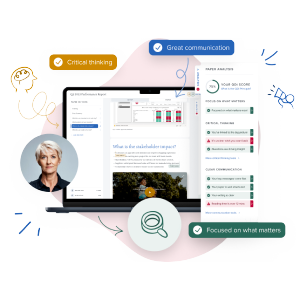Lynne Berry CBE has spent a lifetime in the public and not-for-profit sectors. Most notably, she led the Charity Commission, the Equal Opportunities Commission, and the Royal Voluntary Service, and is now chair of Sustrans — making it easier to walk and cycle — and the Human Tissue Authority — the Regulator of the safe and ethical use of human tissue. Lynne is also a trustee of the Welsh National Opera, and prior to this, was chair of Breast Cancer Now and deputy chair of the Canal and River Trust.
What are the hallmarks of a great board meeting?
The first one is respect — for each other, and for the purpose of the meeting. We need an environment where board members are able to not just express their views but also come to conclusions together. That may sound painfully obvious — but that dynamic isn’t always the norm.
The second one is openness. Reports have a natural tendency to hide the warts, and that’s not just counterproductive but also a fundamental misunderstanding of what the board does. It’s okay to say if things are not going well; I’m not marking your work — but we need the full picture to do our job and support you to find solutions.
“Reports have a natural tendency to hide the warts, and that’s not just counterproductive but also a fundamental misunderstanding of what the board does.”
And finally, it’s focus. As a board member, your role covers strategy, governance, accountability, and making sure the organisation stays true to its purpose. It’s tempting to chase off after every bright idea, but we all have to remember why we’re there.
What’s the role of the chair in making these happen?
Like all leaders, chairs must create common purpose and bridge different views. It’s not your mandate to dictate solutions — you have to be comfortable with the fact that some tensions will remain unresolved. What you can do, though, is turn problems on their heads, so that board members can see them differently and overcome deadlocks.
“It’s not your mandate to dictate solutions. What you can do, though, is turn problems on their heads, so that board members can see them differently.”
Importantly, chairs don’t work alone. Not all organisations have unitary boards but we’re all on the same team, and you can’t build that common purpose without a great relationship with the chief executive. That requires trusting one another — and the best chair-CEO duos are those where one can tell the other, “I don’t really know what to do here.”
What has been the most valuable lesson you’ve learnt during the Covid-19 crisis?
Covid-19 created a lot of openness at board level. Everyone was worried, and everyone was in the dark — and that made it acceptable to be vulnerable. I’d encourage chairs to build on that and remind their board, “It was okay not to know then, and it’s still okay now.”
“Uncertainty might have helped the board conversation, because it meant we moved from focusing just on facts and numbers to discussing our values and behaviours.”
In a strange way, that uncertainty might have helped the board conversation, because it meant we moved from focusing just on facts and numbers — which, at that time, we didn’t have — to discussing our values and behaviours. And whether it’s about Black Lives Matter or how you treat your staff in a pandemic, having a frank debate on these fundamental issues is key to building trust amongst board members.
What is your proudest achievement or the smartest business decision you’ve made?
Bringing together Breast Cancer Now and Breast Cancer Care to create a single organisation providing hope for the future through research and practical care for those going through breast cancer.
Competition can be fierce in the charity sector because of the nature of fundraising: it helps to raise funds if you talk about innovation and uniqueness. But that emphasis can detract from your purpose. The merger helped us focus on what we were all here for.
What book is on your bedside table?
At the moment, I’m reading Molly Keane novels. They’re a bit spiteful yet fun. It’s a world very different from mine!
What is your Golden Rule?
Learn to be calm — or pretend to be if you aren’t!
“Creating a calm environment — where others feel safe to contribute, instead of picking up my anxiety — allows others to blossom.”
When I was young and foolish, I was known for running down the corridors muttering under my breath in frustration. But I’ve come to see that creating a calm environment — where others feel safe to contribute, instead of picking up my anxiety — allows others to blossom.





